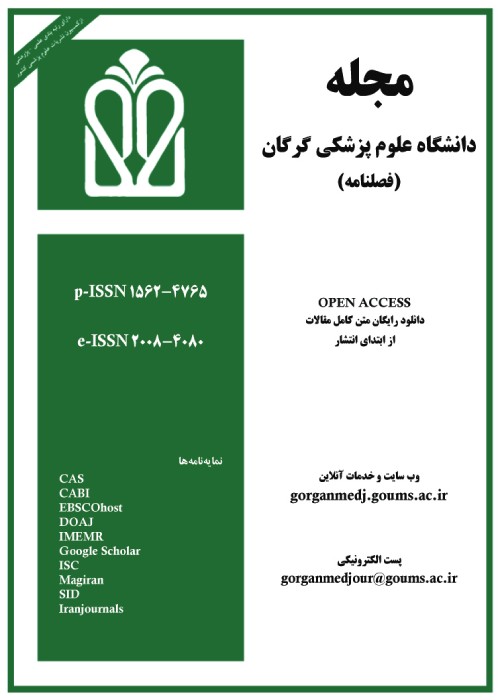Determination of bacteria in gallbladder of patients with cholelithiasis and evaluation of pathogenic factors of the prevalent isolated bacteria
Author(s):
Article Type:
Research/Original Article (دارای رتبه معتبر)
Abstract:
Background and Objective
Various infections and the formation of stones could be the cause for bile duct obstruction of that sterile organ. Determination of pathogenesis factors and the bacteria involved in infections are important in the prevention of disease, and cares needed following surgery. This study was done to determine the bacteria in the gallbladder of patients with cholelithiasis and evaluation of pathogenic factors of the prevalent isolated bacteria.
Methods
In this descriptive laboratory study, 35 samples of gallbladder tissues which contained gallstones were collected under sterile conditions in “Department of General Surgery of Imam Khomeini Hospital”, Tehran, Iran during 2016. The stone types were analyzed and decomposed by chemical procedures, and the bacteria existed in the tissues were also identified using biochemical experiments. The tissues with negative results in microbiological studies were looked for any contaminating bacteria, applying the DNA extracted from gallbladder tissue as a template using F27 and R1492 as the primers for PCR (Polymerase Chain Reaction) amplification of 16SrRNA gene. Those with the positive results of microbiological tests were subjected to the DNA sequencing following gel purification and blasted against the NCBI gene database. The most frequently isolated bacteria were studied according to the intensity of biofilm formation, using the microtitre plate method. CsgF and Ag43 (Flu), the genes involved in the induction of such phenotype were also analyzed in this study. The antibiotic resistance assay of the isolates was performed using disc diffusion procedure.
Results
Thirteen out of thirty five samples of post-surgery gallbladder tissues were found to be infected by different bacteria, including: Klebsiella (3 cases), Escherichia coli (4 cases), Enterobacter (1 case), Staphylococcus aureus (2 cases), Enterococci (2 cases), and Streptococcus (1 case). In 23 out of 35 samples (65.7%), no bacteria could be isolated using microbiological methods. However, in seven out of 23 samples, the amplified 16SrRNA had an indication of Klebsiella (6 cases) and Enterococcus (1 case) isolates. Therefore, the most prevalent genus in gallbladder infections was Klebsiella (47.36%). Chemical analysis showed that the highly frequent compound of gallstones (98%) were of cholesterol and bilirubin. Escherichia coli with fourcases were the highest culture growing isolated bacteria, in all of which, the biofilm formation genes were present. In the two out of four Escherichia coli isolates the intensity of biofilm formation was high. Although, in the remaining two isolates was medium. While, they were found to be sensitive to the most of the antibiotics, they showed resistance to Tetracycline, Ciprofloxacin and Ceftazidime in different ranges.
Conclusion
The present study provided evidence that non-cultural bacteria are hihly present in gallbladder infections. The high potential of the commonly isolated bacteria in biofilm formation should be taken as a warning to follow the precise protocol of antibiotic prescription for treatment of gallbladder infections.Keywords:
Language:
Persian
Published:
Journal of Gorgan University of Medical Sciences, Volume:21 Issue: 3, 2019
Pages:
120 to 128
magiran.com/p2020691
دانلود و مطالعه متن این مقاله با یکی از روشهای زیر امکان پذیر است:
اشتراک شخصی
با عضویت و پرداخت آنلاین حق اشتراک یکساله به مبلغ 1,390,000ريال میتوانید 70 عنوان مطلب دانلود کنید!
اشتراک سازمانی
به کتابخانه دانشگاه یا محل کار خود پیشنهاد کنید تا اشتراک سازمانی این پایگاه را برای دسترسی نامحدود همه کاربران به متن مطالب تهیه نمایند!
توجه!
- حق عضویت دریافتی صرف حمایت از نشریات عضو و نگهداری، تکمیل و توسعه مگیران میشود.
- پرداخت حق اشتراک و دانلود مقالات اجازه بازنشر آن در سایر رسانههای چاپی و دیجیتال را به کاربر نمیدهد.
In order to view content subscription is required
Personal subscription
Subscribe magiran.com for 70 € euros via PayPal and download 70 articles during a year.
Organization subscription
Please contact us to subscribe your university or library for unlimited access!


